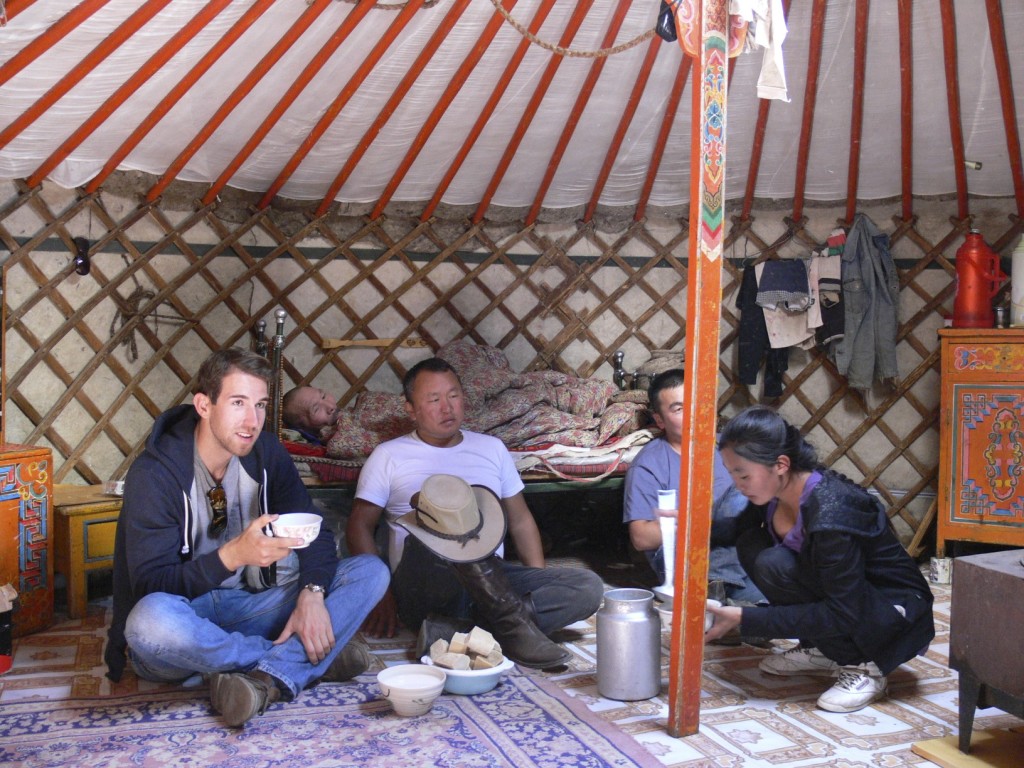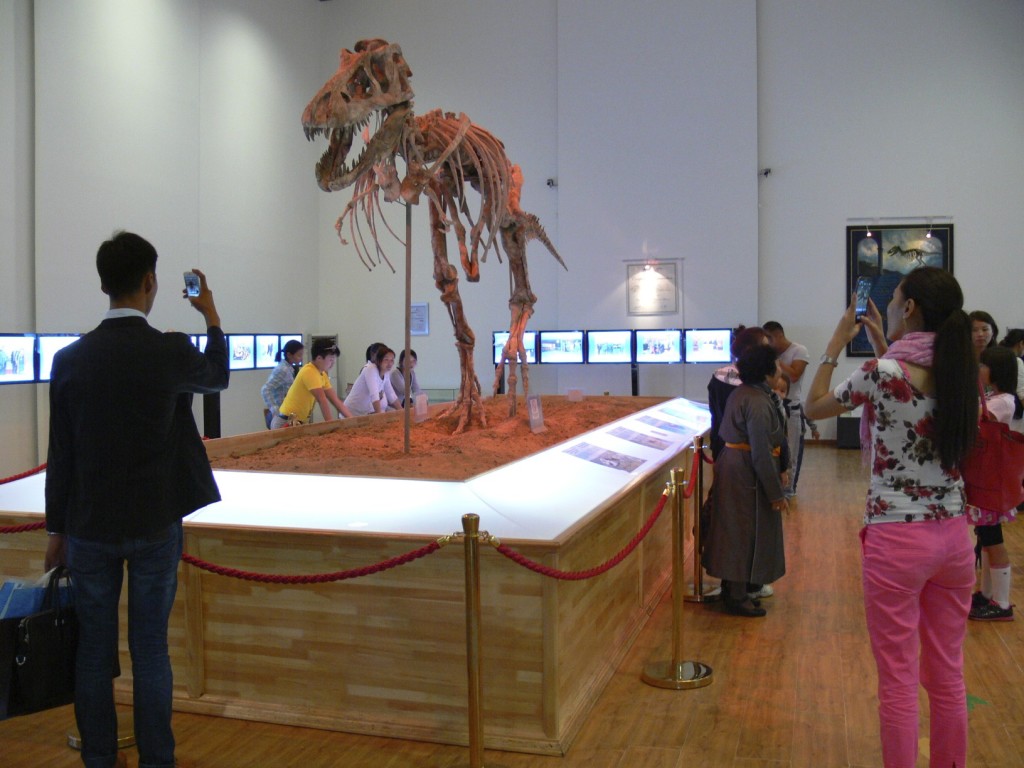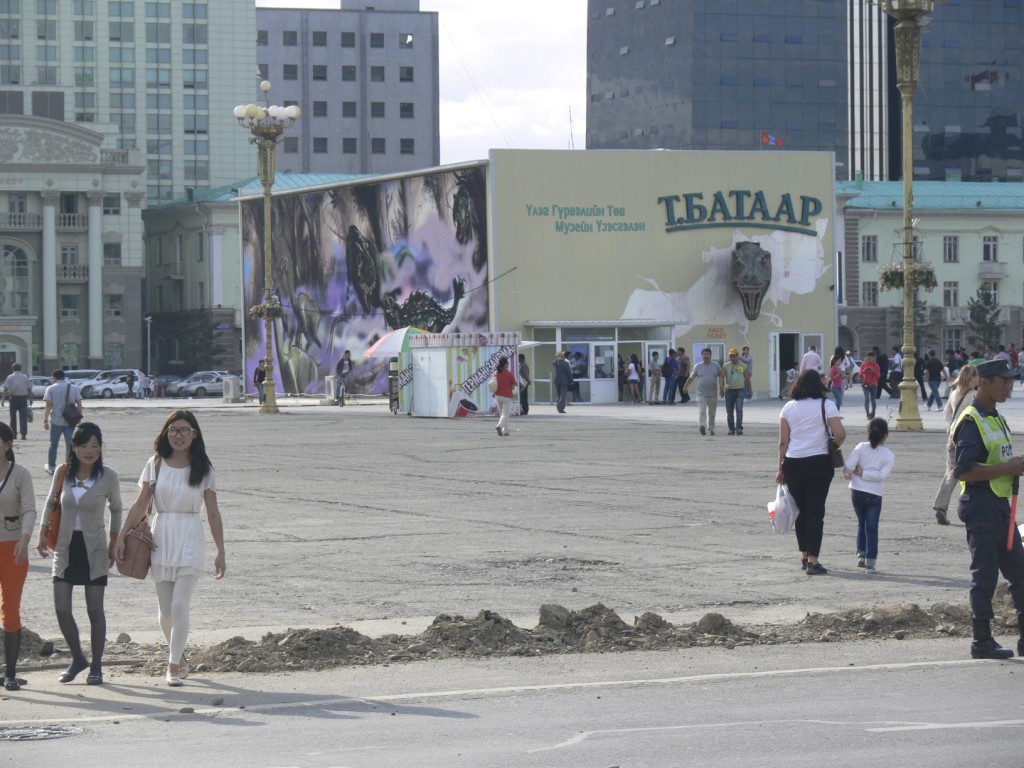
Doing business in the Gobi, August 2013. Left to right: Diej (of Naadam Cashmere), an old man (on the bed), Bodio, Ishee, and (if memory serves) Dash’s daughter.
They say never work with children or animals.
But once I know the rules, I can’t help myself: I like to break them.
Back in 2011, I began work on a national export strategy for Mongolia’s exotic fibre sector.
This encompassed cashmere, of course, and also camel wool (from the two-humped type, the bactrian), and the hair that quickly became my favourite: yak, which is superior to cashmere in almost every way.
But there’s one big problem with yak: in most countries where it’s sourced, like Tibet, it comes only in brown, indeed in one or two shades of dark brown. Monotonous, and virtually un-dyeable, except maybe to black,
But Mongolia has a yak colour, which before I came to town, they used to call “grey.” For me, discovering this shade was like spotting Lana Turner perched on a stool at the soda fountain: I knew right away I had something special on my hands, something with star power.
First, I ran the numbers, and gleaned that 100 times as much cashmere fibre is collected each year in Mongolia as grey yak fibre. Never mind that figure merely represents a low demand for yak and a high demand for cashmere — I knew I could, as it were, spin a yarn around it.
Next, I coaxed the cooperation of one or two knitwear manufacturers in Ulaanbaatar who bought into my ideas.
We changed the name from “grey yak hair,” and fashioned a new pitch: “Mongolian platinum yak down: a hundred times rarer than cashmere.” Immediately, they put the price up 30%.
I thought — and still think — they should have, and could have, doubled or trebled the price. Just add some theatre, I told them: you know, keep the platinum garments under lock and key, a la Peruvian vicuña, in a glass case in a separate section of the store.
Treat it like the most exalted, precious material in the universe.
Initiate a self-fulfilling prophecy.
Today, my engagement with Mongolia and its exotic animals continues in fits and starts. Nothing is easy in Mongolia. Nothing is straightforward.
Case in point: the dinosaur, the Tyrannosaurus bataar, which got up and walked out of the Gobi a few years ago; up and moved to Florida, of all places. Decided to become an illegal immigrant and a mysterious skeletal snowbird after spending X million years in the frozen steppe.
I loved the tale, and though it was widely covered, I didn’t think anyone in the mainstream press had the right angle on it. So I felt I had to do the job myself. My editor at The Wall Street Journal paid me to write the story, but then spiked it — he’d hoped for more emphasis on how they were going to install the dinosaur in the former Lenin museum, but as far as I could work out, that was just a typical Mongol-style rumour; Mongolian officials say all kinds of things to the media.
As I said, nothing to do with Mongolia ever quite goes to plan.
Meanwhile, here’s my article, as commissioned in late 2013 by The Wall Street Journal.
ULAANBAATAR, MONGOLIA—
It’s an impressive feat of both paleontology and privateering. But how did Eric Prokopi expect to get away with it?
“They’re just basically rocks,” self-described commercial paleontologist and convicted fossil smuggler Mr Prokopi reportedly said of the 70-million year old, 8-foot tall skeleton of Tyrannosaurus bataar the T. Rex’s Asian cousin, over which he is now in hot water (though perhaps “deep tar” is a more apt metaphor).
Presumably, however, if Mr. Prokopi truly believed those words, he wouldn’t have gone to the enormous trouble of spiriting the rare dinosaur’s bones out of Mongolia, via Japan and Britain, to the U.S., and then spending almost two years cleaning and articulating the them in his Florida backyard before putting his masterpiece up for auction, where it sold in May 2012 for $875,000 net of dealer’s commission. (The buyer, by telephone, was Coleman Burke, a real estate developer with a genuine expertise in fossils. He fancied this one for the lobby of his New York City office, but when an injunction against the sale was enforced as the auction transpired, Mr. Burke withdrew his winning bid.)
About Mr. Prokopi’s ambitious scheme, the mind reels with questions: firstly, since it is flagrantly illegal (on several grounds) to remove fossils from Mongolian territory and then bring them into the U.S. in cartons falsely labeled on customs forms as containing “reptile heads,” why take the risk? Moreover, since this particular dinosaur specimen could scientifically be validated with near certainty as being of Mongolian provenance, why chance a public auction instead of doing a deal underground (a common occurrence in the international black market for fossils)? Currently awaiting sentencing, having pleaded guilty in December, Mr. Prokopi may have up to 17 years behind bars to consider these questions.
Tyrannosaurus bataar, which means “alarming lizard hero,” lived in the Gobi Desert, and so far that’s the only location its fossilized remains have been found. The species was discovered in 1946 by a Soviet expedition (Mongolia, while never a republic of the USSR, was effectively governed from Moscow between 1924 and 1991). The best guess is that Mr. Prokopi’s specimen was unearthed after that, but details of how he found it, and what role Mongolian locals played in removing it from the ground and from the country, are still scant. It’s reasonable to suspect that Mr. Prokopi had substantial local assistance, and three months before his conviction he told Paige Williams of the New Yorker, “There’s details about my dealings and associations in Mongolia that I’d like to talk about, but I don’t think I can.”
Meanwhile, the object of Mr Prokopi’s heist and handiwork is, rightly, back in Mongolia. It is on grand exhibition, along with the strange-but-true story of its repatriation. (On September 20th, the exhibition moved to Darkhan, Mongolia’s second city, but when this writer saw it, it was in a purpose-built temporary hall in the main square of the capital Ulaanbaatar.) The splendid dino – with a 75% original skeleton whose missing bits have been replaced by casts, apparently fashioned out of resin by Mr, Prokopi in full accordance with professional standards – has been regaled as a hometown hero: since going on public display June 8th, “more than half a million people have seen the Baatar fossil,” according to The UB Post. That’s nearly 20% of Mongolia’s population.
Equally charming and troubling in its nationalistic fervor, this is one of the more curious dinosaur exhibitions you’ll ever see. For example, on display is the Blackberry of Robert Painter, the American lawyer who, with a judge on the other end of this selfsame phone, successfully halted the dinosaur auction in progress, paving the way for the beast’s ferocious comeback.
“I’m impressed at how they’ve laid out the timeline in such intricate detail,” said Jason Speer, an Illinois businessman visiting Mongolia to work with a cashmere company (Mongolia is the world’s number two source of cashmere, after China).
Mr. Speer is referring to the fascinating paper trail of the Mongolian recovery of “their” dinosaur that lines the exhibit’s walls. It started with a stroke of luck: Bolor Minjin, a Mongolian paleontologist working in America, caught wind of the impending auction: “I happened to overhear a news broadcast” only three days beforehand, she relates in her official report, all five pages of which are laid out under glass. The T. bataar specimen had obviously been dug up within her country’s borders, so “I emailed [an] advisor to the president of Mongolia.” The roughly year long intervention, fully documented in the exhibition, concluded with the U.S. Department of Homeland Security repossessing the restored and disassembled skeleton and crating it off to Mongolia in May 2013.
Tellingly, Homeland Security’s “Custody receipt for seized property and evidence” contains the only mention of Eric Prokopi in the whole exhibition. For the Mongolians, it seems Mr. Prokopi barely figures in the story.
Gregg Mikolasek, an environmental surveyor living and working in Mongolia, said that although “I was really happy I got to see this dinosaur,” the gloating tone of the exhibition is misplaced in light of the full context of circumstances. “Despite his improprieties, [Mr. Prokopi] truly did an amazing job preserving this piece of natural history. Odds are if this guy hadn’t done that, this treasure would have been lost.”
Expert opinion lends credence to this view. Philip Currie, president of the Society of Vertebrate Paleontology, veteran explorer of Mongolian digs, and outspoken participant in Mongolia’s campaign to recover the dinosaur, admitted in New Scientist magazine a month after the auction: “By the end of [2011’s] field sessions, I had identified 89 quarries [in the Gobi] from which [T. bataar] skeletons had been extracted: fewer than a third of them had been collected by legitimate expeditions.”
Nonetheless, if Mongolians are at all embarrassed by the fact that a priceless and ancient 24-foot lizard walked out on them, they’re too busy enjoying his homecoming to show it.
Jeremy Hildreth is an identity consultant to cities, countries and companies.



